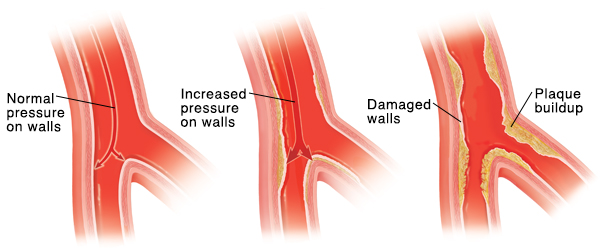What Is High Blood Pressure?
What is High Blood Pressure?
High blood pressure (also called hypertension) is known as the “silent killer.” This is because most of the time it doesn’t cause symptoms. In fact, many people don’t know they have it until other problems develop. In most cases, high blood pressure often requires lifelong treatment.
Understanding blood pressure
The circulatory system is made up of the heart and blood vessels that carry blood through the body. Your heart is the pump for this system. With each heartbeat (contraction), the heart sends blood out through large blood vessels called arteries. Blood pressure is a measure of how hard the moving blood pushes against the walls of the arteries.
High blood pressure can harm your health
In a healthy blood vessel, the blood moves smoothly through the vessel and puts normal pressure on the vessel walls.
High blood pressure occurs when blood pushes too hard against artery walls. This causes damage to the artery walls and then the formation of scar tissue as it heals. This makes the arteries stiff and weak. Plaque sticks to the scarred tissue narrowing and hardening the arteries. High blood pressure also causes your heart to work harder to get blood out to the body. High blood pressure raises your risk of heart attack, also known as acute myocardial infarction, or AMI, heart failure, and stroke. It can also lead to kidney disease, and blindness. In general, if you have high blood pressure, keeping your blood pressure below 130/80 mmHg may help prevent these problems. Your healthcare provider may prescribe medicine to help control blood pressure if lifestyle changes are not enough.
It's important to know your blood pressure numbers. Blood pressure measurements are given as 2 numbers. Systolic blood pressure is the upper number. This is the pressure when the heart contracts. Diastolic blood pressure is the lower number. This is the pressure when the heart relaxes between beats.
Blood pressure is categorized as normal, elevated, or stage 1 or stage 2 high blood pressure:
Normal blood pressure is systolic of less than 120 and diastolic of less than 80 (120/80)
Elevated blood pressure is systolic of 120 to 129 and diastolic less than 80
Stage 1 high blood pressure is systolic is 130 to 139 or diastolic between 80 to 89
Stage 2 high blood pressure is when systolic is 140 or higher or the diastolic is 90 or higher
High blood pressure is diagnosed when multiple, separate readings show blood pressure above 130/80 mmHg. Talk with your healthcare provider if you have questions or concerns about your blood pressure readings.
Measuring blood pressure
An example of a blood pressure measurement is 120/70 (120 over 70). The top number is the pressure of blood against the artery walls during a heartbeat (systolic). The bottom number is the pressure of blood against artery walls between heartbeats (diastolic). Talk with your healthcare provider to find out what your blood pressure goals should be.
Controlling blood pressure
If your blood pressure is too high, work with your doctor on a plan for lowering it. Below are steps you can take that will help lower your blood pressure.
Choose heart-healthy foods. Eating healthier meals helps you control your blood pressure. Ask your doctor about the DASH eating plan. This plan helps reduce blood pressure by limiting the amount of sodium (salt) you have in your diet. DASH also encourages eating plenty of fruits and vegetables, low-fat or non-fat dairy, whole-grains, and foods high in fiber, and low in fat. This also provides an enhanced amount of potassium which can also help lower blood pressure.
Reduce sodium. Reducing sodium in your diet reduces fluid retention. Fluid retention caused by too much salt increases blood volume and blood pressure. The American Heart Association’s (AHA) "ideal" sodium intake recommendation is 1,500 milligrams per day. However, since American's eat so much salt, the AHA says a positive change can occur by cutting back to even 2,400 milligrams of sodium a day.
Maintain a healthy weight. Being overweight makes you more likely to have high blood pressure. Losing excess weight helps lower blood pressure.
Exercise regularly. Daily exercise helps your heart and blood vessels work better and stay healthier. It can help lower your blood pressure.
Stop smoking. Smoking increases blood pressure and damages blood vessels.
Limit alcohol. Drinking too much alcohol can raise blood pressure. Men should have no more than 2 drinks a day. Women should have no more than 1. (A drink is equal to 1 beer, or a small glass of wine, or a shot of liquor.)
Control stress. Stress makes your heart work harder and beat faster. Controlling stress helps you control your blood pressure.
Facts about high blood pressure
Feeling OK does not mean that blood pressure is under control. Likewise, feeling bad doesn’t mean it’s out of control. The only way to know for sure is to check your pressure regularly.
Medicine is only one part of controlling high blood pressure. You also need to manage your weight, get regular exercise, and adjust your eating habits.
High blood pressure is usually a lifelong problem. But it can be controlled with healthy lifestyle changes and medicine.
Hypertension is not the same as stress. Although stress may be a factor in high blood pressure, it’s only one part of the story.
Blood pressure medicines need to be taken every day. Stopping suddenly may cause a dangerous increase in pressure.
Updated:
November 09, 2018
Sources:
2014 Evidence-Based Guideline for the Management of High Blood Pressure in Adults Report From the Panel Members Appointed to the Eighth Joint National Committee (JNC 8). James, P. JAMA. 2014, is. 311, ed. 5, pp. 507-20.
Reviewed By:
Cunningham, Louise, RN,Fraser, Marianne, MSN, RN,Gandelman, Glenn, MD, MPH,Image reviewed by StayWell medical illustration team.
